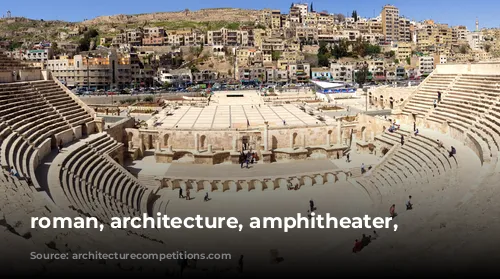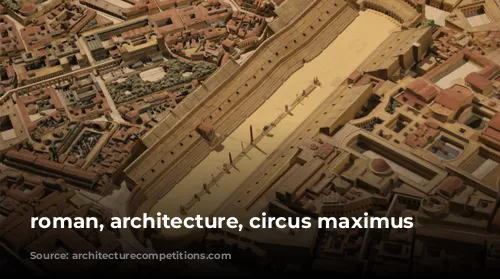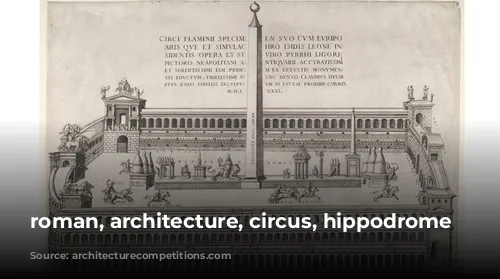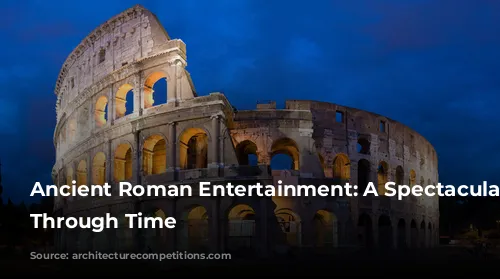Ancient Roman architecture is famous for its remarkable innovations, which enabled the Romans to create and maintain a vast empire for centuries. While religious and political buildings were significant, the heart of Roman public life revolved around structures built for entertainment.

The Grand Stage of Ancient Roman Entertainment
Ancient Roman entertainment still captivates us today, with countless movies and TV shows depicting the lives of gladiators, chariot racers, and other remarkable figures. Many of these scenes are set in iconic structures like the Colosseum in Rome, which still stands as a testament to the grandeur of Roman entertainment.
Theatres were also popular in Ancient Rome, but they were often temporary structures. While they boasted elaborate sculptures and architectural features, no permanent remains survive to confirm eyewitness accounts. Some accounts describe stages adorned with hundreds of columns and thousands of statues, showcasing the Romans’ penchant for using architecture to enhance spectacle.
However, the primary stage for public entertainment was the amphitheatre.

The Amphitheatre: Heart of Roman Entertainment
These large, circular, open-air venues stood at the core of ancient Roman entertainment, hosting a wide range of events from gladiatorial contests to public spectacles like executions. Literally meaning “theatre all around”, amphitheatres featured raised seating surrounding a central stage. They are distinct from circuses and hippodromes, which were rectangular and primarily designed for races, and stadia, built for athletics.
Over 200 amphitheatres are documented, with one standing out as the most renowned and still attracting visitors today: the Colosseum.

The Colosseum: A Monument to Roman Grandeur
Also known as the Flavian Amphitheatre, Rome’s Colosseum began construction under the reign of Vespasian in 72 AD and was completed eight years later under Emperor Titus. Its scale is still impressive today, encompassing 6 acres and seating an estimated 50,000 to 80,000 spectators during its peak. The Colosseum sits atop a honeycomb structure of arcades and vaults, with passages for spectators, rooms for gladiators, and cells for animals used in the entertainment.
Despite the loss of the original interior sheathing of colored marble, the Colosseum’s sturdy structure still welcomes millions of visitors each year.
From Greece to Rome: The Evolution of the Hippodrome
The Greek design of the hippodrome was adopted and adapted by Roman architecture into a circus. Unlike amphitheatres, hippodromes were typically square or rectangular, essentially racecourses flanked by tiers of seats and a central grandstand. Their elongated circuits were originally designed for chariot and horse racing.
The hippodrome concept originated with the ancient Greeks and was referred to in Roman architecture as a circus. The largest Roman circus was the U-shaped Circus Maximus.
The Circus Maximus: A Monument to Roman History
The Circus Maximus was the oldest and largest public space in Rome. Legend claims that its original plans were laid out in the 6th century BCE by the first Roman kings, but it wasn’t until the reign of Julius Caesar that it reached its current form.
Located between the Aventine and Palatine Hills, the Circus Maximus boasted an arena measuring 600 by 225 meters, surpassing the Circus of Flaminius and the Circus of Maxentius as the largest in Rome, capable of seating around 300,000 spectators.
Its primary function was as a chariot racetrack and host of the Roman Games honoring the Roman God, Jupiter. The competitors, often slaves, would race in small chariots drawn by horses for a chance to earn their freedom, while throngs of Roman citizens watched and bet on the outcome.
The last official chariot race at the Circus Maximus took place in 549 CE, after which the site was largely abandoned. In the 19th century, it was used for industrial purposes, but was eventually cleared and converted into a public park resembling its original form in the 1930s.
From the grand amphitheatres to the vast hippodromes, ancient Roman entertainment left a lasting legacy on the world. These structures stand as a testament to the Romans’ love of spectacle, their ingenuity in engineering and architecture, and their ability to create spaces that captivated and entertained a vast empire for centuries.
